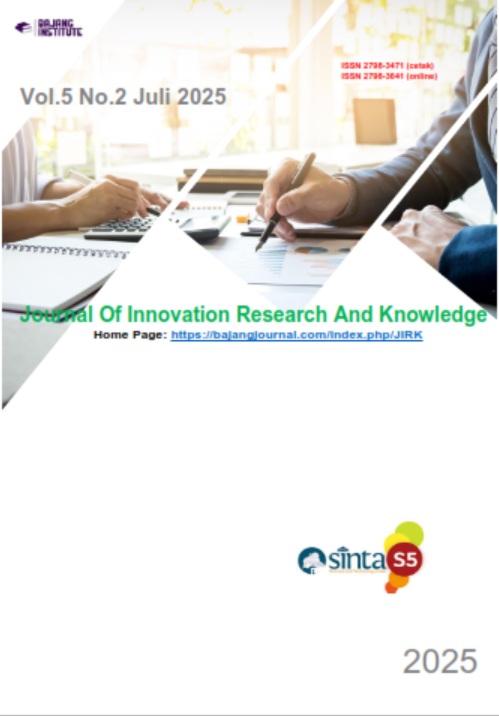PENGARUH PEMBERIAN TENS & TEKNIK PNF TERHADAP PENURUNAN NYERI, PENINGKATAN LGS, DAN PENINGKATAN AKTIVITAS FUNGSIONAL PADA PASIEN FROZEN SHOULDER
Keywords:
Frozen shoulder, TENS, Teknik PNF, Lingkup Gerak Sendi (LGS), Derajat Nyeri, Aktivitas Fungsional BahuAbstract
Latar Belakang: Kondisi frozen shoulder didahului oleh adanya rasa nyeri yang muncul sewaktu menggerakan bahu yang dapat menyebabkan imobilisasi jangka panjang jika dibiarkan. Gangguan frozen shoulder biasanya terjadi pada wanita usia dewasa akhir atau pre-lansia sampai masuk usia lansia, yaitu dari usia 40 tahun ke atas, yang lebih sering menggunakan kedua lengannya untuk beraktivitas sehari-hari. Tujuan penelitian: Penelitian ini bertujuan untuk mengetahui pengaruh pemberian TENS dan teknik PNF terhadap derajat nyeri, lingkup gerak sendi (LGS), dan aktivitas fungsional bahu pada pasien frozen shoulder. Metode: Penelitian ini bersifat quasi-experiment dengan tipe one group pre-test & post-test design yang dilakukan pada bulan Mei-Juni 2025 dengan total sampel yang memenuhi kriteria inklusi berjumlah 20 pasien. Penelitian dilakukan di Puskesmas Seyegan. Partisipan menerima intervensi TENS dan teknik PNF selama 4 kali pertemuan. Pengukuran nyeri dengan menggunakan Visual Analogue Scale (VAS), pengukuran LGS menggunakan goniometer, serta aktivitas fungsional bahu dengan kuesioner Shoulder Pain and Disability Index (SPADI). Hasil: Uji hipotesis menggunakan paired sample t-test menunjukkan bahwa pemberian TENS dan teknik PNF secara signifikan menurunkan nyeri (mean±SD pre, post: 5,42±1,56, 1,92±0,75), meningkatkan LGS pada gerakan eksternal rotasi (44,75±6,78, 73,75±9,30), abduksi (75,25±23,42, 110,75±20,72), internal rotasi (42,00±7,50, 61,50±5,87), dan fleksi (83,00±18,66, 122,00±18,09), serta meningkatkan aktivitas fungsional bahu (57,14±19,93, 21,23±8,88). Kesimpulan: Pemberian intervensi TENS dan teknik PNF secara rutin dapat memberikan efek yang cukup signifikan
References
Carley, P., Burkhart, K. L., & Sheridan, C. (2021). Virtual Reality vs Goniometry: Intraclass Correlation Coefficient to Determine Inter-Rater Reliability for Measuring Shoulder Range of Motion. Journal of allied health, 50(2), 161–165.
Cho, C. H., Song, K. S., Kim, B. S., Kim, D. H., & Lho, Y. M. (2018). Biological Aspect of Pathophysiology for Frozen Shoulder. BioMed research international, 2018, 7274517. https://doi.org/10.1155/2018/7274517
Cogan, C. J., Cevallos, N., Freshman, R. D., Lansdown, D., Feeley, B. T., & Zhang, A. L. (2022). Evaluating Utilization Trends in Adhesive Capsulitis of the Shoulder: A Retrospective Cohort Analysis of a Large Database. Orthopaedic journal of sports medicine, 10(1), 23259671211069577. https://doi.org/10.1177/23259671211069577
Costa, L. C., Andrade, A., Lial, L., Moreira, R., Lima, A. C., Magvinier, A., Lira, R., Aragão, A., Ulisses, P. H., Crespo, E., Orsini, M., Teixeira, S., & Bastos, V. H. (2017). Investigation of alpha band of the electroencephalogram before and after a task of proprioceptive neuromuscular facilitation. Journal of exercise rehabilitation, 13(4), 418–424. https://doi.org/10.12965/jer.1734990.495
Date, A., & Rahman, L. (2020). Frozen shoulder: Overview of clinical presentation and review of the current evidence base for management strategies. Future Science OA, 6(10). https://doi.org/10.2144/fsoa-2020-0145
Ebrahimzadeh, M. H., Moradi, A., Bidgoli, H. F., & Zarei, B. (2019). The Relationship between Depression or Anxiety Symptoms and Objective and Subjective Symptoms of Patients with Frozen Shoulder. International journal of preventive medicine, 10, 38. https://doi.org/10.4103/ijpvm.IJPVM_212_17
Elgendy, M. H., & Abd El-khalek, W. O. A. (2019). Validity and Intra-Rater Reliability of Laser Goniometer Versus Electro-Goniometer in Measuring Shoulder Range of Motion. International Journal of Physiotherapy, 4(6), 169–176. https://doi.org/10.15621/ijphy/2019/v4i6/163929
Ghias, S., Saeed, H., Ahmed, M., Faisal, M., Solangi, T. A., Asim, H. A. B., & Ahmad, J. (2024). Effectiveness of PNF Pattern in Regular Physical Therapy Sessions on Functional Mobility in Frozen Shoulder: PNF Pattern in Frozen Shoulder Therapy. THE THERAPIST (Journal of Therapies & Rehabilitation Sciences), 46-50.
Hamed Hamed, D., Rodríguez-Pérez, C., Pruimboom, L., & Navarro-Ledesma, S. (2024). Relationship Between Metabolic Profile, Pain, and Functionality in Patients with Frozen Shoulder: A Cross-Sectional Study. Healthcare (Switzerland), 12(23), 1–14. https://doi.org/10.3390/healthcare12232444
Ho, C. A., Yun Ling, J. C., & Abdul Karim, S. (2022). Cross-cultural adaptation and measurement properties of the Malay Shoulder Pain and Disability Index. PloS one, 17(3), e0265198. https://doi.org/10.1371/journal.pone.0265198
Khumairoh, S., Fatmarizka, T., & Hidayati, A. (2022). Manajemen Fisioterapi Pada Kasus Frozen Shoulder : A Case Report. Jurnal Kesehatan Dan Fisioterapi (Jurnal KeFis), 2(3), 21–25.
Lin, M. L., Chiu, H. W., Shih, Z. M., Lee, P. Y., Li, P. Z., Guo, C. H., Luo, Y. J., Lin, S. C., Lin, K. Y., Hsu, Y. M., Pang, A., & Pang, W. (2019). Two transcutaneous stimulation techniques in shoulder pain: Transcutaneous Pulsed Radiofrequency (TPRF) versus transcutaneous electrical nerve stimulation (TENS): A comparative pilot study. Pain Research and Management, 2019, 1–9. https://doi.org/10.1155/2019/2823401
Lin, P., Yang, M., Huang, D., Lin, H., Wang, J., Zhong, C., & Guan, L. (2022). Effect of proprioceptive neuromuscular facilitation technique on the treatment of frozen shoulder: a pilot randomized controlled trial. BMC Musculoskeletal Disorders, 23(1), 1–10. https://doi.org/10.1186/s12891-022-05327-4
Mezian, K., & Chang, K. V. (2019). Contrast-enhanced Ultrasonography for the Diagnosis of Frozen Shoulder. Journal of medical ultrasound, 27(3), 146–147. https://doi.org/10.4103/JMU.JMU_103_18
Milenia, S., & Rahman, I. (2021). Penatalaksanaan Fisioterapi Pada Kasus Osteoarthritis genu Bilateral Menggunkan Modalitas Tens, SWD dengan Terapi Latihan. Jurnal Stikes Sitihajar, 3, 125–131.
Muhith, A. (2015). Kemampuan Fungsional Lansia di UPT Panti Werdha “Majapahit” Mojokerto. Hospital Majapahit, 2.
Noboa, E., López-Graña, G., Barco, R., & Antuña, S. (2015). Distension test in passive external rotation: Validation of a new clinical test for the early diagnosis of shoulder adhesive capsulitis. Revista espanola de cirugia ortopedica y traumatologia, 59(5), 354–359. https://doi.org/10.1016/j.recot.2014.10.005
Pandey, V., & Madi, S. (2021). Clinical Guidelines in the Management of Frozen Shoulder: An Update! Indian Journal of Orthopaedics, 55(2), 299–309. https://doi.org/10.1007/s43465-021-00351-3
Parjoto, S. (2020). Terapi Listrik untuk Modulasi Nyeri. Surakarta: Poltekkes Kemenkes Surakarta.
Patil, S. N., & Sudha Bugatha, R. (2018). “Comparative Efficacy of Transcutaneous Electrical Nerve Stimulation [Tens] and Pendular Exercises V/S Ultra Sound and Rhythmic Stabilization in Clinically Diagnosed Frozen Shoulder [Adhesive Capsulitis] Using Spadi Scale.”a Random Study. 4(11), 300–308.
Purnomo, D., Abidin, Z., & Puspitasari, N. (2017). Pengaruh Short Wave Diathermy (SWD) dan Terapi Latihan terhadap Frozen Shoulder Dextra. Jurnal Fisioterapi Dan Rehabilitasi, 1(1), 65–71. https://doi.org/10.33660/jfrwhs.v1i1.12
Ramirez J. (2019). Adhesive capsulitis: Diagnosis and management. American Family Physician, 99(5), 297–300.
Tedla, J. S., & Sangadala, D. R. (2019). Proprioceptive neuromuscular facilitation techniques in adhesive capsulitis: A systematic review and meta-analysis. Journal of Musculoskeletal Neuronal Interactions, 19(4), 482–491.
Vance, C. G. T., Dailey, D. L., Rakel, B. A., & Sluka, K. A. (2014). Using TENS for pain control: the state of the evidence. Pain Management, 4(3), 197–209. https://doi.org/10.2217/pmt.14.13
Venturin, D., Giannotta, G., Pellicciari, L., Rossi, A., Pennella, D., Goffredo, M., & Poser, A. (2023). Reliability and validity of the Shoulder Pain and Disability Index in a sample of patients with frozen shoulder. BMC Musculoskeletal Disorders, 24(1), 1–9. https://doi.org/10.1186/s12891-023-06268-2
Widianingrum, R., Hargiani, F., Kusuma, W., & Halimah, N. (2021). Perbedaan Pengaruh Pemberian SWD Dan Mobilisasi Sendi Terhadap Peningkatan Kemampuan Fungsional Bahu. Jurnal Keperawatan Muhammadiyah, 6(4), 2021.
Wijaya, W. A. (2015). Penatalaksanaan Fisioterapi Pada Kondisi Frozen Shoulder Sinistra e.c Capsulitis Adhesiva Di RSUD Panembahan Senopati Bantul.
Yehia, R. M., & Elmeligie, M. M. (2022). Effectiveness of extracorporeal shockwave therapy for frozen shoulder in perimenopausal diabetic women. Biomedical Human Kinetics, 14(1), 109–116. https://doi.org/10.2478/bhk-2022-0014















